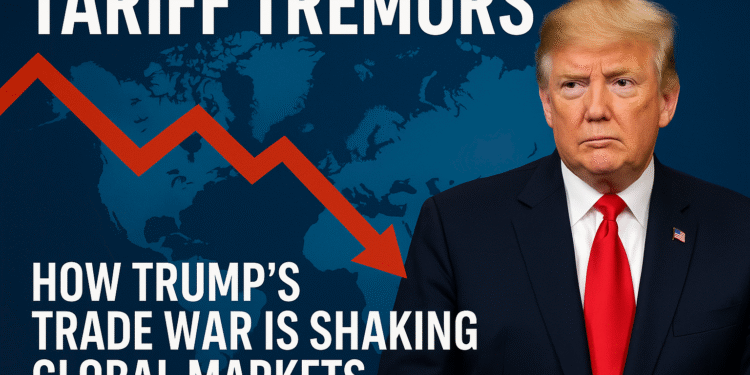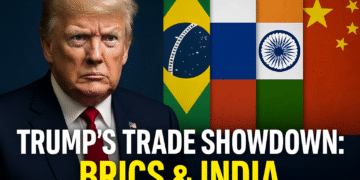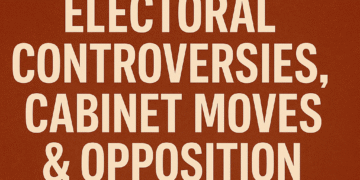President Trump’s recent tariff move has caused shockwaves across the globe. It has sparked worries about a new era of trade tensions.

This tariff is part of a larger trade strategy. It includes tariffs on imports from the UK and South Korea. India has criticized this, fearing it will hurt its economy.
The world is watching closely. The trade war’s effects could be huge. It might lead to market downturns and increase global tensions.
Key Takeaways
- The imposition of tariffs has sparked concerns of a global trade war.
- India has criticized the move, citing concerns about the impact on its economy.
- The trade war has far-reaching implications, including market downturns and rising geopolitical stakes.
- The US has also imposed similar tariffs on UK and South Korean imports.
- The move is part of a broader trade policy under President Trump.
The Bombshell Announcement: Trump’s 25% Tariff Decision
The US has shocked the world by imposing a 25% tariff on Indian exports. This move has raised fears of a global trade war. It’s part of a larger trade plan that has also targeted the UK and South Korea.
Timeline and Scope of the New Tariff Policy
The new tariff policy will be rolled out in phases. The first phase will focus on key Indian export sectors. The US administration says it’s to address trade imbalances.
The tariffs will cover a wide range of products, from textiles to machinery. This has caused concern among Indian exporters, who fear for their businesses.
Similar Actions Against UK and South Korea
The US hasn’t stopped at India. It has also imposed tariffs on the UK and South Korea. This has led to a united call from these countries for diplomatic talks.
The world is watching closely as the situation unfolds. The chance of a wider trade war is a big concern. The effects on global supply chains and economies will be key to watch.
“We’re facing a tough situation, and our industries will likely be hit hard,” said an Indian Commerce Ministry spokesperson. “We’re looking at all options to lessen the tariff impact.”
Understanding US 25% Tariffs on Indian Exports: Trump Tariffs India 2025 US-India Trade War Global Context
The US has put a 25% tariff on Indian exports, causing a big trade issue. This is part of the Trump administration’s plan to fix the US trade deficit with India.
Key Sectors and Products Affected
The 25% tariff on Indian exports will hit many sectors hard. Some of the main ones include:
- Textiles: India’s textile industry, a big part of its exports, will face big tariffs.
- Pharmaceuticals: Indian pharmaceutical exports to the US will be hit, affecting Indian drug makers’ competitiveness.
- IT Services: IT services aren’t directly tariffed, but the trade tension could affect them indirectly.
Other products like agricultural goods, chemicals, and machinery will also be affected. The impact will vary based on the product and trade agreements.
Implementation Timeline and Mechanics
The 25% tariff will be introduced in stages. The Trump administration has set a timeline for a gradual increase in tariffs over the next quarter.
The tariff’s implementation will involve:
- Identification of Tariff Lines: The US Trade Representative (USTR) will pick specific tariff lines for the 25% tariff.
- Notification to Affected Parties: Indian exporters and the Indian government will be told about the tariffs and the timeline.
- Gradual Implementation: The tariffs will be introduced slowly to reduce disruption.

Immediate Market Reactions Worldwide
The news of the 25% tariff on Indian exports has caused big reactions in global markets. Stock markets in India have seen big swings, with sectors hit by tariffs falling.
Worldwide, reactions are mixed. Some see it as the US protecting its industries, while others worry about more trade tensions.
Currency markets have also reacted, with the Indian rupee moving against the US dollar. The global trade world is watching closely, as this could change international trade a lot.
The Economic Justification: US Trade Deficit with India
The trade deficit between the US and India is a big issue. The US wants to fix this imbalance with new policies.
The $45.7 Billion Deficit in 2024
In 2024, the US deficit with India was $45.7 billion. The US says this is why they put tariffs on Indian goods. India sells a lot more to the US than it buys.
| Year | US Exports to India | US Imports from India | Trade Deficit |
|---|---|---|---|
| 2024 | $21.3 billion | $67.0 billion | $45.7 billion |
| 2023 | $20.5 billion | $63.2 billion | $42.7 billion |
US Administration’s “Unfair Trade” Accusations
The US says India is not playing fair in trade. India says the US is wrong about this.
India is accused of unfair trade practices and favoring local businesses. The US wants easier access for American companies in India.
Official Economic Rationale from Washington
The US tariffs aim to cut the trade deficit and ensure fair trade. The US thinks tariffs will help American businesses and workers.
The main reasons for the tariffs are:
- To reduce the trade deficit by selling more to India.
- To address unfair trade practices by India.
- To protect US economic interests through nationalism and protectionism.
The trade fight between the US and India could affect both countries and the world. Knowing why the US imposed tariffs is key to understanding this situation.
Political Calculations: Tariffs in an Election Cycle
The Trump administration’s decision to impose a 25% tariff on Indian exports is linked to the upcoming election. This move is seen as a populist trade policy. It aims to win over voters worried about the US trade deficit and job market.

Populist Messaging and Voter Appeal
The tariffs are part of a populist trade strategy. It aims to tackle unfair trade practices. By being tough on trade, the administration wants to connect with voters who feel trade agreements have hurt American workers.
Domestic Political Advantages of Trade Confrontation
Using tariffs as a political tool has several benefits. It shows the administration’s dedication to protecting American jobs. This could increase its approval ratings among certain voters.
| Political Advantage | Description |
|---|---|
| Protecting American Jobs | Tariffs are seen as a measure to safeguard employment in industries affected by foreign competition. |
| Demonstrating Toughness on Trade | The administration’s stance on tariffs is perceived as a strong response to unfair trade practices. |
| Boosting Domestic Industries | By making imports more expensive, tariffs can encourage consumers to buy domestic products, potentially boosting local economies. |
Historical Patterns of Trade Policy During Elections
Trade policy often changes with elections. The current tariff imposition follows a pattern. Incumbent administrations use trade measures to gain political leverage.
Understanding these historical patterns helps us see the motivations behind current trade tensions. It also shows their likely impact on the election cycle.
Immediate Market Fallout in India
The news of a 25% US tariff on Indian goods led to a big sell-off in Indian stocks. This shows how sensitive the market is to such news.
Stock Market Reactions
The Indian stock market fell sharply after hearing about the tariffs. The main worry was how it would affect Indian exports and the economy.
Key market reactions include:
- A big drop in the BSE Sensex and NSE Nifty indices.
- More market volatility, with investors quickly changing their portfolios.
- Downsides in sectors that rely on exports.
Impact on Major Indian Export Sectors
The US tariffs will hit hard on major Indian export sectors. These include textiles, IT services, and pharmaceuticals.
The textiles sector is very vulnerable because it exports a lot to the US. The IT services sector might also face challenges, even if indirectly, due to possible lower US demand.
“The imposition of tariffs by the US will undoubtedly have a cascading effect on our exports. We need to strategize and diversify our export markets to mitigate this impact.” – Indian Commerce Ministry Official
The immediate market fallout in India shows the need for quick action. Industries and policymakers must find ways to deal with the new trade situation. As things develop, the focus will be on lessening the impact and finding new markets and strategies.
India’s Official Response and Criticism
India’s government strongly opposes the US tariffs, calling them ‘unjustified’ and ‘detrimental’ to trade between the two countries. Indian officials have quickly spoken out, worried about the economic effects of these tariffs.
Statements from the Indian Commerce Ministry
The Indian Commerce Ministry has led the response, strongly condemning the US tariffs. Minister Piyush Goyal has said these tariffs harm India’s interests and go against fair trade practices. The ministry warns of damage to key sectors like textiles, pharmaceuticals, and IT services.

Diplomatic Channels and Negotiation Attempts
India has also used diplomatic efforts to tackle the issue. Officials from both sides have talked, trying to find a solution that works for everyone. Diplomatic negotiations are ongoing, with India wanting tariffs removed and the US looking to reduce its trade deficit.
Public Sentiment and Media Reaction in India
Most people in India are unhappy with the US tariffs, seeing them as unfair. The media has echoed this view, with many editorials criticizing the US. They urge the Indian government to take a strong stance, possibly by imposing retaliatory tariffs on US goods.
The situation is complex, with both countries navigating diplomacy and trade policies. As the situation evolves, the world will watch the responses from both governments closely.
Collateral Damage: UK and South Korea’s Predicament
The global trade scene is changing fast. The UK and South Korea are feeling the impact of the US’s new tariff plans. The US’s 25% tariff is hitting not just India but also other big economies hard.
UK Export Sectors Under Pressure
The UK’s export sectors are under a lot of pressure from the US tariffs. Industries like machinery, electronics, and pharmaceuticals are likely to be hit. The UK’s trade council is watching closely and looking at ways to help British businesses.
South Korea’s Trade Council Reaction
South Korea is also feeling the strain from its trade with the US. The South Korean trade council has spoken out about the tariffs. They are looking at diplomatic ways to solve the problem. Sectors like automotive, electronics, and steel are most at risk.
Coordination Possibilities Among Affected Nations
As things get worse, there’s a chance for the UK, South Korea, and India to work together. They might join forces to talk to the US about the tariffs. This could happen through the WTO or direct talks with the US.
| Country | Affected Sectors | Potential Actions |
|---|---|---|
| UK | Machinery, Electronics, Pharmaceuticals | Trade Council Monitoring, Diplomatic Efforts |
| South Korea | Automotive, Electronics, Steel | Trade Council Statement, WTO Negotiations |
| India | Textiles, IT Services, Pharmaceuticals | Retaliatory Tariffs, Diplomatic Talks |
The table shows the sectors hit by tariffs and what the UK, South Korea, and India might do. It shows the need for these countries to work together to tackle the trade tensions.
Global Economic Ripple Effects
The US tariffs have set off a chain reaction in the global economy. They affect many sectors and markets around the world. Everyone is watching closely, waiting to see how things will change.
Investor Sentiment Across Markets
When the US tariffs news hit, investor feelings changed. The uncertainty made investors cautious. They are now waiting to see what happens next.
Key observations include:
- A decline in investor confidence in trade-sensitive sectors
- Increased volatility in stock markets
- A shift towards safer investment options

Price Increases in US Domestic Markets
The tariffs will make things more expensive in the US. Imported goods will cost more, affecting both consumers and businesses. This could lead to higher prices and inflation.
The impacts on US domestic markets include:
- Higher prices for consumers
- Increased costs for businesses relying on imported goods
- Potential inflationary trends
Currency Fluctuations and Capital Flows
Currency values and capital flows are being watched closely. The tariffs could cause big changes in currency values. Investors are adjusting their portfolios in response.
The effects of the US tariffs are complex and far-reaching. It’s important for investors, businesses, and policymakers to stay informed. They need to adapt to the new trade environment.
The Retaliation Question: India’s Options
With US tariffs now in effect, India faces a tough choice. The government must decide if and how to retaliate against these tariffs.
Potential Countermeasures
India has several ways to fight back against US tariffs. These include:
- Imposing tariffs on US goods imported into India, targeting sectors such as technology and agriculture.
- Invoking World Trade Organization (WTO) rules to dispute the US tariffs.
- Exploring alternative trade agreements with other countries to offset the losses.
Strategic Considerations are key in making this decision. Indian policymakers must think about the economic, diplomatic, and long-term effects of their choices.
Strategic Considerations for Indian Policymakers
Indian policymakers are looking at several factors. These include:
- The impact on Indian exports and the economy.
- The diplomatic implications of retaliation, including the strain on US-India relations.
- The risk of a full-blown trade war.
Lessons from Previous Trade Disputes are being studied. Historical conflicts, like the US-China trade war, offer insights into possible outcomes.
Lessons from Previous Trade Disputes
Previous trade disputes teach us several things:
| Trade Dispute | Key Outcome | Relevance to India |
|---|---|---|
| US-China Trade War | Tariff escalation, eventual negotiations | India can learn from China’s negotiation strategies. |
| EU-US Trade Tensions | Periodic tariff impositions and resolutions | India may benefit from the EU’s approach to trade disputes with the US. |
| India’s Previous Trade Disputes | Varied outcomes, including WTO interventions | Past experiences will guide India’s current decisions. |
In conclusion, India’s response to US tariffs will be carefully thought out. It will consider various options, strategic factors, and lessons from past disputes. The goal is to protect Indian interests while avoiding negative outcomes.
Supply Chain Shifts and Beneficiaries
US tariffs are changing the way companies do business globally. A 25% tariff on Indian exports has pushed companies to look for new places to make things. They are trying to find ways to deal with these tariffs.
Alternative Manufacturing Hubs: Vietnam and Others
Vietnam is becoming a key player in the global supply chain. It has low labor costs, good infrastructure, and trade deals that help businesses. Countries like Bangladesh and Indonesia are also gaining interest as alternatives to China and India.

More countries are being looked at for their ability to handle more manufacturing. This trend is likely to keep growing as companies adjust to the new trade rules.
| Country | Competitive Advantage | Potential Impact |
|---|---|---|
| Vietnam | Low labor costs, favorable trade agreements | High |
| Bangladesh | Low labor costs, growing textile industry | Moderate |
| Indonesia | Large workforce, improving infrastructure | Moderate |
China’s Position in the Reshuffled Trade Landscape
China’s role in global trade is being watched closely. The US tariffs have both challenges and opportunities for China. China has been a big player in making things, but the tariffs could change that.
China might see more trade if countries like India lose business. But, the tariffs could also slow down China’s exports as global demand changes.
Corporate Adaptation Strategies
Companies are finding ways to deal with the new trade rules. They are spreading out their supply chains, finding ways to avoid tariffs, and changing where they make things.
Some companies are paying the tariffs themselves, while others are raising prices. The choice depends on the company’s position in the market and how sensitive customers are to price changes.
Companies that can quickly adjust to these changes are likely to do well in the new trade world.
Long-Term Strategic Implications
The US has started to put tariffs on Indian goods. This big change in trade policy is more than just a move. It shows a major shift in how countries trade and plan their economies.
Changing Patterns in Global Trade Architecture
The US’s move to put tariffs on India is part of a bigger trend. It’s about protectionism and changing trade patterns. This could make global supply chains change, with countries like Vietnam and China possibly gaining.
Key implications include:
- More trade between India and countries not hit by tariffs.
- Changes in global trade agreements and groups.
- How big companies plan their production and where they buy things.
US-India Bilateral Relations Beyond Trade
The tariff move also affects US-India relations in many ways, not just trade. The partnership between the two will face challenges as they deal with these trade issues.
“The US-India relationship is multifaceted, involving cooperation in defense, technology, and climate change. But trade tensions could strain these efforts.”
How well they handle their trade issues will show if they can keep working together in other areas.
Regional Alliances and Geopolitical Considerations
Regional alliances and big picture politics are key after the US tariff decision. Countries in the area might need to look at their trade policies and alliances again.
Potential geopolitical shifts include:
- Strengthening of regional trade agreements to counter US tariffs.
- Changes in the global political scene, with big economies possibly realigning.
- More focus on trade talks to get better deals.
Conclusion: Navigating the New Trade Reality
The world is adjusting to a new trade scene, and knowing about US tariffs is key. A 25% tariff on Indian exports has caused big waves. It’s making global trade tensions worse and changing US trade plans for 2025.
Looking at how US tariffs affect global trade gives us a clear picture. These tariffs are hitting India’s export sectors hard. They’re also affecting the country’s economy. To deal with this new trade world, we need to understand the changes in trade.
As things keep changing, it’s important to stay updated and adjust to the new trade scene. The US trade policy in 2025 will have big effects. It will change global trade tensions and the economic outlook.
To navigate this new trade world, we need to get the complex mix of trade policies, economic signs, and world politics. By keeping up with these changes, we can better face the challenges and chances that come with the new trade scene.
FAQ
What is the US tariff rate imposed on Indian exports?
The US has set a 25% tariff on Indian goods. This move has raised concerns about a new era of trade disputes.
Which countries are affected by Trump’s tariffs beside India?
The UK and South Korea are also facing these tariffs. This shows the US has a broader trade strategy.
What is the US trade deficit with India that the US administration cites as a reason for the tariffs?
The US trade deficit with India was $45.7 billion in 2024. The US says this shows unfair trade practices.
How will the US tariffs on Indian exports affect the Indian economy?
The tariffs will hit hard on key Indian export sectors. The impact on India’s economy is being closely watched.
What is India’s response to the US tariffs?
India has strongly criticized the tariffs. The commerce ministry has spoken out, and diplomatic talks are underway.
How are global markets reacting to the US tariffs on Indian exports?
Indian stock markets have seen a big drop. Investor sentiment worldwide has also been affected.
What are the possible countermeasures India can take against the US tariffs?
India is looking at different options. Strategic thinking and lessons from past disputes are guiding their decisions.
How will the US tariffs affect global supply chains?
The tariffs have led to big changes in global supply chains. Companies are now looking at places like Vietnam for manufacturing.
What are the long-term strategic implications of the US tariffs on global trade?
The tariffs have big implications for global trade. They are changing the trade landscape and affecting US-India relations beyond trade.
Are other countries like the UK and South Korea coordinating with India in response to the US tariffs?
There’s a chance that affected countries might work together. This shows the global impact of this trade issue.
How will the US tariffs on Indian exports affect the US domestic market?
Prices in the US are going up as tariffs take effect. Currency changes and capital flows are being watched closely.









